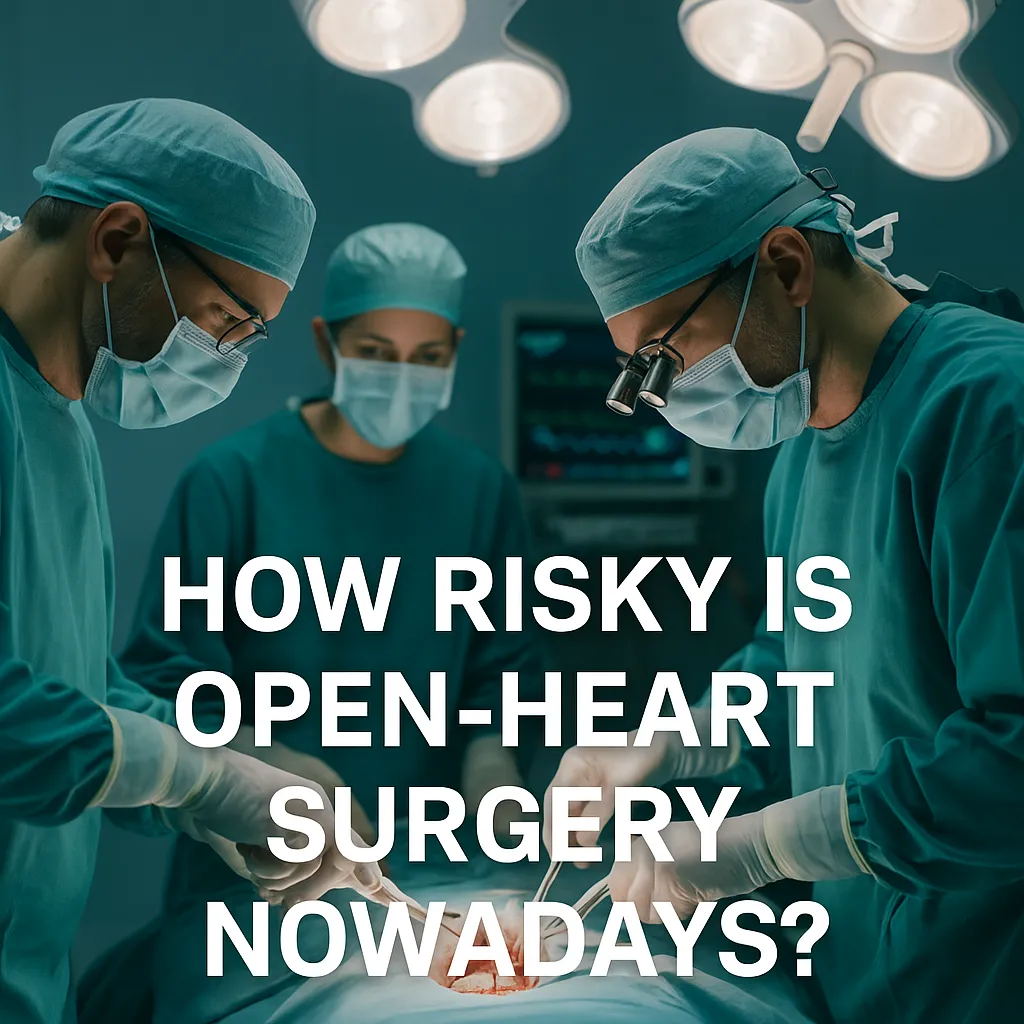
How Risky is Open-Heart Surgery Nowadays? An Evidence-Based Perspective
Introduction
Open-heart surgery has saved millions of lives since its first successful cases in the mid-20th century. Back then, these operations carried significant mortality and complication rates due to limited technology, rudimentary anesthesia techniques, and a lack of sophisticated postoperative care.
Fast forward to today—advances in surgical techniques, cardiopulmonary bypass (CPB) technology, anesthesia, and critical care have made open-heart surgery safer than ever.
But “safer” doesn’t mean “risk-free.” Every surgical procedure carries inherent risks, especially when it involves stopping the heart, connecting the patient to a heart-lung machine, and operating on delicate cardiovascular structures. For Advanced Practice Registered Nurses (APRNs) and RNs, understanding current risk profiles is essential for guiding patients, supporting the surgical team, and optimizing recovery.
Defining Open-Heart Surgery
Open-heart surgery generally refers to procedures requiring median sternotomy (opening the chest through the breastbone) and cardiopulmonary bypass. Common types include:
Coronary artery bypass grafting (CABG)
Heart valve repair or replacement (mitral, aortic, tricuspid)
Congenital heart defect repair
Aortic surgery (e.g., ascending aortic aneurysm repair)
Heart transplant
Mortality Rates: Then vs. Now
Historical Context
In the 1960s and 70s, operative mortality for CABG could exceed 10%, and valve surgeries often had even higher risk due to limited understanding of perioperative physiology.
Current Statistics
Modern high-volume cardiac centers now report:
CABG mortality: ~1–3% for elective, isolated CABG in low-risk patients.
Aortic valve replacement (surgical): 2–5% in elective cases.
Mitral valve repair: often <2% in experienced hands.
Complex or redo surgery: 5–10% depending on comorbidities.
Key Factors Lowering Risk Today:
Advanced imaging and diagnostics for better surgical planning.
Minimally invasive approaches for selected cases.
Intraoperative transesophageal echocardiography (TEE) for real-time guidance.
Enhanced recovery protocols in post-op care.
Risk Factors in Modern Cardiac Surgery
Even with safer techniques, certain patient-specific and procedure-specific factors influence risk:
Patient-Related Risks
Age >75 years
Preexisting heart failure or reduced ejection fraction
Chronic kidney disease
Diabetes mellitus
Chronic lung disease
History of stroke or peripheral vascular disease
Poor nutritional status or frailty
Procedure-Related Risks
Emergency vs. elective surgery
Redo (reoperative) sternotomy
Combined surgeries (e.g., CABG + valve)
Prolonged cardiopulmonary bypass time
Aortic manipulation in heavily calcified vessels
Common Complications and Their Current Incidence
1. Stroke
Incidence: ~1–3% in most series, higher in elderly or aortic disease patients.
Modern Prevention: Minimizing aortic manipulation, using epiaortic ultrasound, strict blood pressure management.
2. Bleeding and Reoperation
Incidence: 2–6%.
Prevention: Improved anticoagulation monitoring, hemostatic agents, and refined surgical techniques.
3. Infection
Sternal wound infection (mediastinitis): <1–2% in most centers.
Risk reduction: Perioperative antibiotics, tight glucose control, negative pressure wound therapy for high-risk patients.
4. Arrhythmias
Atrial fibrillation (AF): 20–40% incidence post-CABG or valve surgery.
Prevention/Management: Beta-blockers, amiodarone prophylaxis, electrolyte optimization.
5. Renal Complications
Acute kidney injury: 10–30% (mild), dialysis-dependent AKI in ~2–5%.
Reduction strategies: Optimizing perfusion pressure, avoiding nephrotoxic drugs, careful volume management.
6. Respiratory Issues
Atelectasis, pneumonia, prolonged ventilation.
Prevention includes early mobilization, incentive spirometry, and aggressive pulmonary care.
Why Outcomes Are Better Today
1. Surgical Advancements
Smaller incisions (minimally invasive sternotomy or thoracotomy).
Robotic-assisted valve surgery in select centers.
Off-pump CABG techniques for high-risk patients.
2. Anesthesia and Perfusion
Better monitoring (TEE, cerebral oximetry).
Safer cardioplegia solutions for myocardial protection.
Goal-directed perfusion strategies during CPB.
3. Postoperative Critical Care
Early extubation protocols.
Advanced hemodynamic monitoring.
Multidisciplinary ICU teams with cardiac specialty training.
4. Prehabilitation and Patient Optimization
Managing anemia, nutrition, and comorbidities pre-op improves outcomes.
Smoking cessation and pulmonary conditioning pre-surgery.
Patient Education: Managing Perception vs. Reality
Many patients hear “open-heart surgery” and immediately imagine high risk and prolonged suffering. APRNs are uniquely positioned to bridge the gap between outdated perceptions and current realities.
Key Counseling Points:
Modern mortality rates are low in elective cases.
Most patients are discharged within 5–7 days.
Recovery is faster with enhanced recovery protocols.
Risks are individualized—healthier patients fare extremely well.
The APRN Role in Reducing Risk
Preoperative Phase
Risk assessment using tools like the STS Risk Calculator or EuroSCORE.
Optimizing chronic conditions (e.g., tight glucose control in diabetics).
Educating patients on surgery, recovery, and warning signs.
Intraoperative Collaboration
Supporting anesthesia and perfusion teams with hemodynamic monitoring.
Ensuring communication between surgical and nursing teams for high-risk cases.
Postoperative Management
Monitoring for early signs of complications.
Leading early mobilization efforts.
Coordinating multidisciplinary care for smooth transitions to step-down units or home.
Open-Heart Surgery vs. Less Invasive Options
For certain conditions, Transcatheter Aortic Valve Replacement (TAVR), MitraClip, or percutaneous coronary intervention (PCI) may be alternatives. However, open-heart surgery remains the gold standard in:
Multi-vessel coronary artery disease in diabetics.
Complex valve pathology.
Combined surgical repairs.
What the Future Holds
Further integration of AI in surgical planning to predict complications.
Broader use of minimally invasive and hybrid procedures.
Customizable prosthetic valves with enhanced durability.
Personalized anticoagulation and antiplatelet strategies.
Conclusion
Is open-heart surgery risky nowadays?
For many patients—especially in elective, planned settings—the risk is lower than ever in history. Advances in surgical skill, technology, and perioperative care mean that outcomes are overwhelmingly positive, with most patients returning to normal or improved function within months.
For APRNs, staying informed about evolving cardiac surgical practices ensures that we can accurately counsel patients, identify early complications, and support safe recovery. Through ongoing continuing education, we can continue to raise the bar for postoperative outcomes and patient satisfaction.










